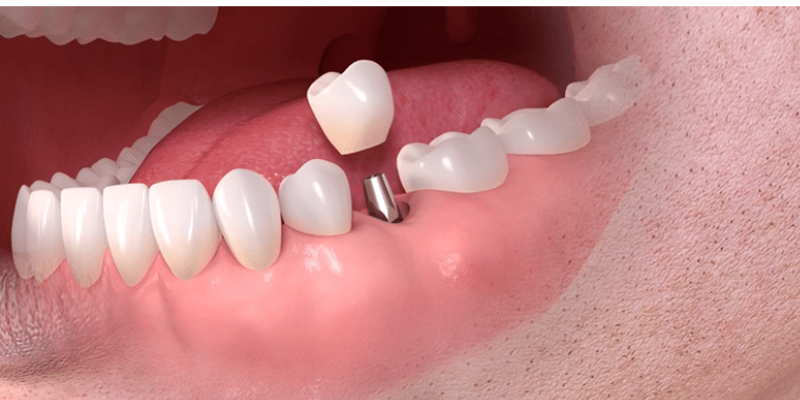Dental Implant Bridge
Dental Implant Bridge If you have missing teeth, a dental implant bridge can be utilized to fill up the gaps in your smile. A dental bridge is a prosthetic tooth (known as a pontic) that is kept in place by abutment teeth on each side of the gap. Pontics are made of a number of materials, including gold, but they’re most commonly fashioned of porcelain to match your natural teeth.
Traditional bridges and implant-supported bridges are very similar. Instead of using dental crowns to cover adjacent teeth, implant-supported bridges are supported by thin titanium posts placed into the jaw. The size of the bridge will determine the number of posts necessary.
The implants in an implant-supported bridge help your bone feel the force of your bite, keeping it stimulated. Although bone resorption may occur beneath the bridge, it will be less severe than bone loss associated with a detachable bridge or no bridge at all. A dental bridge requires more time and effort than a routine checkup. If you’ve ever had a dental crown, receiving a bridge will feel very familiar. Preparing your teeth and placing the bridge will take more than one appointment. Any dental work on the supporting teeth, such as a filling or a root canal, must be completed prior to the procedure.
Who Is A Good Candidate For Dental Implant Bridge?
To be eligible for dental implants, you must have good oral health and enough jawbone tissue to sustain the implants. A preliminary surgery like as a bone graft or sinus lift can be used to restore implant candidacy in certain patients. We must first treat any oral health problems you may have, such as gum disease or tooth decay, before we may place implants. Smokers must agree to stop smoking for a period of time before and after implant surgery. They should, in theory, be able to break the habit for good. Patients with uncontrolled diabetes may be unable to receive implants. We can assist you in developing a plan that will allow implants to become an important part of your smile.
When two or more consecutive teeth are lost, an implant-supported bridge can provide a comfortable, natural-looking replacement. Additionally, implants are the only tooth replacement method that does not cause jawbone atrophy. An implant-supported restoration restores your entire tooth from root to crown. By replacing tooth roots, the implant instructs your body to send resources to that part of your jaw. If tooth roots are missing, the body will begin to disseminate jaw bone tissue elsewhere. Implant posts, if properly cared for, can last a lifetime, allowing for long-term oral health.
What Makes Dental Implant Bridge Different?
An implant-supported bridge is a solid and permanent alternative for patients who have lost multiple teeth. Replacing lost or decayed teeth is critical to maintaining long-term oral health. More than just an ugly gap in your smile might be caused by a missing tooth. Your remaining teeth may shift around the gap as a result of tooth loss, altering the alignment of your smile and possibly altering your facial features. You may be unable to chew healthful foods if you have missing teeth. Removable partial dentures and other tooth replacement solutions aren’t as stable as implant-supported bridges. An implant bridge can restore most of your chewing function, allowing you to eat whatever you desire once more.
While a traditional dental bridge can prevent the majority of tooth loss-related issues, an implant-supported bridge provides a number of advantages. Traditional bridges rely on the support of neighboring teeth. Before the bridge can be fixed in place with dental cement, these seemingly healthy teeth must be altered. Because the bridge has secured with implants rather than natural teeth, no healthy teeth must have ground down to replace a missing tooth.
How Many Implants Used In A Bridge?
An implant-supported bridge is a tooth replacement that has permanently attach ed to dental implants. Depending on the patient’s situation, the number of implants required to attach the bridge varies, but a common arrangement is two implants supporting three teeth: two “cap” teeth on either end bridged by another tooth in the middle.
When a tooth has extracted, bone loss might continue. Dental implants can prevent this. When you lose a tooth, the bone in your jaw no longer receives the pressure sensations that tell it to regenerate due to the power of your bite. As a result, your body begins to resorb the bone, and the jawbone in that location shrinks.
A fixed implant-supported bridge is a more cost-effective option than implanting and crowning each lost tooth individually. However, because of the implant procedure, it is more expensive than most detachable options. The therapy you pick to replace missing teeth determine by your personal health and financial circumstances. We’ve always delighted to talk about all of your options with you.
How Does Dental Implant Procedure Work?
It takes several appointments to get an implant-supported bridge. The installation of dental implants is the initial stage. The bone and gums around the implants normally require several months to recover after initial insertion. The dentist will take impressions of your mouth to create a mold once the implant sites have healed.
The lab technician will manufacture your bespoke crown using the resulting model of your teeth, which will color-match to your existing teeth. You may fit with a temporary bridge while the lab technician works on the final bridge. The dentist will either screw or cement the final bridge into place on the implants once it arrives.
Other Types Of Dental Bridges
A conventional bridge is the most common type of dental bridge. A pontic tooth is a tooth that has linked to two dental crowns that will cover neighbouring teeth. The dentist must file down the other teeth in order to fit the crowns over them. The crowns (also known as abutments) have secured with a composite bonding resin over your altered teeth. A cantilever bridge is identical to a typical bridge, except that instead of two abutments, the pontic has attached to only one. This bridge has typically used for teeth in the back of the mouth because it is only fix on one side.
Do Breast Implants Get Bigger After Surgery or Is There a Problem?
If you have experienced something that has made, you wonder “do breast implants get bigger after surgery?” no, breast implants do not get bigger after surgery. If a patient is experiencing enlargement of their implants, it could be due to several factors, such as capsular contracture, weight gain, or shifting of the implant. It is important to consult a plastic surgeon for an evaluation if you experience any changes in your implants after surgery. Sometimes, a revision procedure may be necessary to correct any issues.

It is also important to note that the implant size will remain the same – they will not get larger over time. During the initial consultation, patients should discuss with their surgeon the expected size of their implants after surgery, and any potential risks associated with implant sizing. It is important to ensure that patients understand the possible outcomes of their procedure before committing to surgery. Finally, it is essential to follow up with your plastic surgeon for regular check-ups after surgery, ask them, “do breast implants get bigger after surgery?” so any issues can be addressed as quickly as possible. This will help ensure that your breast implants remain healthy and safe. If you have any other questions like “how breast implant surgery is performed?” you can contact a health care provider.



